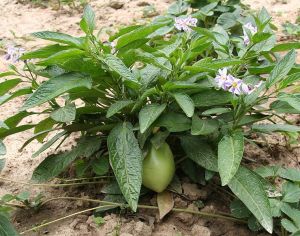
SYNOPSIS:
Organic agriculture and biodiversity have in recent years brought about a rediscovery of many “forgotten” vegetables that people especially in Europe and France conscientiously tried to forget as they reminded them of the privations suffered during WWII. The same people had then to make do with untraditional vegetables because potatoes, carrots and so on were confiscated by occupying forces or their own armies.
With sustainibility and bioagriculture made more important by the deficiencies of modern mass agriculture, those “forgotten” vegetables have suddenly come to the fore for the pleasure of all, and that of course of vegetarians and vegans!
This particular series of postings will introduce these vegetables one by one. I hope they will become useful for a long time to come to all my vegan and vegetarian friends!
1) Scorsonere/Oyster Plant, 2)Potimarron, 3) Vitelotte, 4) Rutabaga, 5) Cardon, 6) Panais/Parsnips , 7) Patisson, ![]() Topinambour, 9) Crosne, 10) Cerfeuil Tubereux, 11) Poiree, 12) Oca, 13) Ulluque/Ulluco, 14) Tigernuts, 15) Capucine tubereuse-Maschua, 16) Chataigne de Terre-Great Pignut, 17) Yacon, 18) Balsamite/Costmary, 19) Sikkim Cucumber, 20) Tree Spinach, 21) Chayote, 22) Strawberry Blite, 23) Purslane
Topinambour, 9) Crosne, 10) Cerfeuil Tubereux, 11) Poiree, 12) Oca, 13) Ulluque/Ulluco, 14) Tigernuts, 15) Capucine tubereuse-Maschua, 16) Chataigne de Terre-Great Pignut, 17) Yacon, 18) Balsamite/Costmary, 19) Sikkim Cucumber, 20) Tree Spinach, 21) Chayote, 22) Strawberry Blite, 23) Purslane
Here is a palnt that can be considered both as a vegetable and a fruit depending upon its maturity.
Also considered as a great ornamental plant!

Pepino (Spanish/English) or Poire-melon (pear-melon in French) or Solanum muricatum in Latin is a species of evergreen shrub native to South America and grown for its sweet edible fruit. It is known as pepino dulce (“sweet pepino”) or simply pepino.
The pepino dulce fruit resembles a melon (Cucumis melo) in color and flavor and thus it is also called pepino melon or melon pear, but pepinos are only distantly related to melons and pears.
Another common name, “tree melon”, is more often used for the Papaya (Carica papaya) and the pepino dulce plant does generally not look much like a tree.
The fruit is common in markets in Colombia, Ecuador, Bolivia, Peru and Chile, but less often overseas because it is quite sensitive to handling and does not travel well. Attempts to produce commercial cultivars and to export the fruit have been made in New Zealand and Chile.
They are being increasingly grown in Europe, France and Belgium in particular, where they can be found in all kinds of dishes.
Moreover, in the United States the fruit is known to have been grown in San Diego before 1889 and in Santa Barbara by 1897.

The plant is grown primarily in Chile, New Zealand and Western Australia. In Chile, more than 400 hectares are planted in the Longotoma Valley with an increasing proportion of the harvest being exported. Colombia, Peru, and Ecuador also grow the plant, but on a more local scale. Outside of the Andean region, it been grown in various countries of Central America, Morocco, Spain, Israel, and the highlands of Kenya. In the United States several hundred hectares of the fruit are grown on a small scale in Hawaii and California. More commercially viable cultivars have been introduced from New Zealand and elsewhere in more recent times. As a result, the fruit has been introduced into up-scale markets in Japan, Europe and North America and it is slowly becoming less obscure outside of South America.

Pepino and kiwano salad
It is a vegetable/fruit valuable for its vitamin C as it contains 29 mg per 100 g.
Depending on its maturity, its taste varies from a slightly sweet cucumber to that of a pear or melon.
Most adapted to salads, although can be cooked when immature.
RECOMMENDED RELATED SITES
Not-Just-Recipes, Bengal cuisine, Cooking Vegetarian, Frank Fariello, Gluten-free Vegan Family, Meatless Mama, Warren Bobrow、Breakfast, Lunch, Dinner and Punch, Kirsten’s Kitchen, Vegan Epicurean
——————————–
Please check the new postings at:
sake, shochu and sushi
—————————————-
日本語のブログ
—————————————-
No comments:
Post a Comment